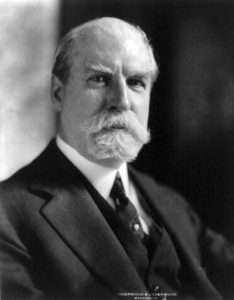The Volokh Conspiracy
Mostly law professors | Sometimes contrarian | Often libertarian | Always independent
Today in Supreme Court History: April 11, 1862
4/11/1862: Chief Justice Charles Evans Hughes's birthday.

Editor's Note: We invite comments and request that they be civil and on-topic. We do not moderate or assume any responsibility for comments, which are owned by the readers who post them. Comments do not represent the views of Reason.com or Reason Foundation. We reserve the right to delete any comment for any reason at any time. Comments may only be edited within 5 minutes of posting. Report abuses.
Please to post comments




Pierson v. Ray, 386 U.S. 547 (decided April 11, 1967): state judges are immune from §1983 liability for judicial acts (here, an allegedly racist sentencing decision against plaintiffs who were trying to integrate a whites-only bus station) (this case established the doctrine of “qualified immunity” -- arresting police officers had defense of “good faith and probable cause” under statute later declared unconstitutional)
New York Indians v. United States, 170 U.S. 1 (decided April 11, 1898): need another treaty (or Congressional authorization) to throw Indian lands open to settlement after tribe did not move onto land within time required by treaty
Specht v. Patterson, 386 U.S. 605 (decided April 11, 1967): can’t sentence someone for something he wasn’t convicted for even though related to offense for which he was convicted (convicted for “indecent liberties” carrying maximum 10 year sentence but then sentenced for indeterminate term under state Sex Offenders Act)
Granville-Smith v. Granville-Smith, 349 U.S. 1 (decided April 11, 1955): striking down Virgin Islands statute requiring six weeks residency before filing for divorce because V.I. could only legislate on local matters and statute was designed to apply to those outside
The Linseed King, 285 U.S. 502 (decided April 11, 1932): admiralty law applied to suit arising from ferry sinking after hitting ice in lower Hudson River (between Edgewater, N.J. and 96th Street, Manhattan)
United States v. Lefkowitz, 285 U.S. 452 (decided April 11, 1932): need warrant for “general exploratory search” of residence incident to arrest for violation of liquor laws (more or less overruled, see discussion in Arizona v. Gant, 2009)
The Northern Belle, 154 U.S. 571 (decided April 11, 1870): affirming damages arising from breaking apart of barge on sand bar; barge had rotten timbers and though wind was violent, if properly repaired would not have foundered
Joseph Schlitz Brewing Co. v. United States, 181 U.S. 584 (decided April 11, 1901): bottles and corks are not “ingredients” of beer and therefore brewer not entitled to refund of tariffs on “imports” such as the hops and barley; brewer had argued that bottled beer is in the nature of an ingredient because the beer has to be in the bottle for heating to prevent second fermentation (I think I’ll order just from the tap from now on)
Hale v. Kentucky, 303 U.S. 613 (decided April 11, 1938): conviction of black man vacated upon showing that blacks had been excluded from grand jury service
Smiley v. Holm, 285 U.S. 355 (decided April 11, 1932): where state (Ohio) must be redistricted, but proposed redistricting was vetoed by governor, there are no districts and Representatives have to be elected at large
"Granville-Smith v. Granville-Smith"
It seems the divorcing parties both wanted the divorce so they weren't going to argue against the Virgin Islands law under which they sought the divorce. One side of a key issue being unrepresented, the Court appointed Erwin Griswold as a friend of the court to argue against the V. I. law, and Griswold won - the law was indeed struck down. Basically the Court seems to have regarded the law as a divorce-mill law to let divorcing couples evade the divorce laws of their own states.
Interesting
Thanks
Smiley v. Holm, 285 U.S. 355 (decided April 11, 1932): where state (Ohio) must be redistricted, but proposed redistricting was vetoed by governor, there are no districts and Representatives have to be elected at large
I think this case should be considered to be de facto overruled by Reynolds v. Sims, 377 U.S. 533 (1964) and its progeny.
Unclear about that. In Smiley the Court was extrapolating from 2 U.S.C. §4, which states that if a state gets more representatives due to the latest census, those extra reps are elected at large until the state is redistricted. That statute is no longer on the books, though Westlaw doesn’t say whether it was repealed or just renumbered. (The opinion was by Hughes, noted by Josh today — winner of the Charles Evans Hughes lookalike contest — who maybe was too busy combing his beard and miscited the statute.)
P.S. Also I made a mistake — it was Minnesota, not Ohio.
The main importance of Smiley today is its implications on the "independent state legislature theory." The governor in the case had vetoed the legislature's redistricting plan. Legislators argued that Article 1, Section 4 of the Constitution gives redistricting authority to the "legislature", so that the governor's purported veto was of no effect. The Court disagreed, holding that "legislature" just referred to the general lawmaking process. The Court, however, hasn't been particularly consistent in this, sometimes holding that "legislature" means "legislature", and sometimes holding that "legislature" means "the general lawmaking process", depending on which part of the Constitution it is interpreting.
Thanks
The successor statute must be 2 USC 2a(c), which calls for for at-large elections in certain cases where a state is not redistricted "in the manner provided by the law thereof".
The Constitution does not require congressional districts, but gives Congress the power to regulate "the times, place, and manner of elections for senators and representatives," which it did in 1967, prohibiting at-large House elections for states with more than one representative. The impetus was the fear that Southern states might make House elections at-large to dilute the black vote and get around recent Supreme Court rulings. At-large districts, though permitted, were used relatively rarely in American history, mostly in the nation's very early history, and then, generally one or two used in combination with districts. If a court faced the situation today in which a state had failed to draw districts, it would almost certainly just take it upon itself to draw them.
Congress outlawed at-large districts long before 1967, but before 1967 there was an exception for when a state had gained new representatives via apportionment and hadn't had a chance to redraw its lines yet. 1967 made it an across-the-board ban. (Except, of course, for states with just one rep.)
Yes, you are correct. Perhaps it would have been better to say Congress finally eliminated them.
In fact, the Smiley case figured into the 1967 law. Congress feared a state could by deliberate inaction fail to redistrict, and then have a court use that precedent to declare there were no districts in the state, so all House elections would be at-large.
TIL that it actually worked the other way, too: pre-1967, if a state lost a representative and the state hadn't gotten around to redistricting, then it would also revert to at-large.
The 1967 law everyone's talking about is apparently the Uniform Congressional District Act, 2 U.S.C. 2-c, but it only prohibits at-large representatives (except when a state has only one district of course). It doesn't say what happens when a state gains or loses seats and redistricting hasn't happened yet.